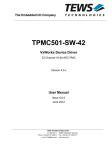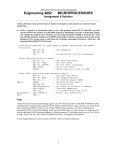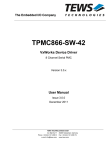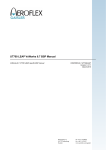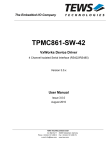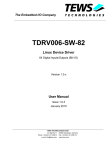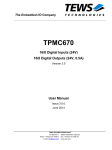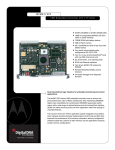Download User Manual - TEWS TECHNOLOGIES
Transcript
The Embedded I/O Company CARRIER-SW-42 VxWorks Device Driver IPAC Carrier Version 3.0.x User Manual Issue 3.0.0 December 2011 TEWS TECHNOLOGIES GmbH Am Bahnhof 7 25469 Halstenbek, Germany Phone: +49 (0) 4101 4058 0 Fax: +49 (0) 4101 4058 19 e-mail: [email protected] www.tews.com CARRIER-SW-42 This document contains information, which is proprietary to TEWS TECHNOLOGIES GmbH. Any reproduction without written permission is forbidden. VxWorks Device Driver IPAC Carrier TEWS TECHNOLOGIES GmbH has made any effort to ensure that this manual is accurate and complete. However TEWS TECHNOLOGIES GmbH reserves the right to change the product described in this document at any time without notice. Supported Modules: TPCI100 TPCI200 TCP201 TCP211 TCP212 TCP213 TCP220 TVME200 TVME201 TVME210 TVME211 TVME220 TVME230 PCI40 CPCI100/200 TEWS TECHNOLOGIES GmbH is not liable for any damage arising out of the application or use of the device described herein. 2007-2011 by TEWS TECHNOLOGIES GmbH Issue Description Date 1.0.0 First Issue September 16, 2005 1.1.0 Structure definition (ipac_resource) and example applications modified November 22, 2005 1.2.0 SBS TECHNOLOGIES Carrier Card Support January 11, 2006 1.2.1 Support of custom carrier boards April 10, 2006 1.2.2 New Address TEWS TECHNOLOGIES LLC ChangeLog.txt added to file list December 5, 2006 1.3.0 Type of Parameters in ipFindDevice() changed June26, 2007 2.0.0 VxBus and SMP support January 27, 2010 2.0.1 Legacy vs. VxBus Driver modified March 26, 2010 3.0.0 VxWorks 64-Bit Support added December 5, 2011 CARRIER-SW-42 - VxWorks Device Driver Page 2 of 35 Table of Contents 1 2 INTRODUCTION......................................................................................................... 4 INSTALLATION.......................................................................................................... 5 2.1 Legacy vs. VxBus Driver ................................................................................................................6 2.2 VxBus Driver Installation ...............................................................................................................6 2.2.1 Direct BSP Builds.................................................................................................................7 2.3 Legacy Driver Installation ..............................................................................................................8 2.3.1 Include the Device Driver in VxWorks Projects ...................................................................8 2.3.2 Special Installation for Intel x86 based Targets ...................................................................8 2.3.3 BSP Dependent Adjustments ..............................................................................................9 3 CONFIGURATION.................................................................................................... 10 3.1 VME Bus Carrier Board Setup .....................................................................................................10 3.2 Auto Interrupt enable Facility ......................................................................................................11 4 INTERFACE FUNCTIONS........................................................................................ 12 4.1 ipCarrierInit....................................................................................................................................12 4.2 ipCarrierPciInit ..............................................................................................................................13 4.3 ipFindDevice..................................................................................................................................14 4.4 ipFreeDevice..................................................................................................................................19 4.5 ipac_map_space ...........................................................................................................................20 4.6 ipac_request_irq ...........................................................................................................................22 4.7 ipac_free_irq..................................................................................................................................24 4.8 ipac_interrupt_ack ........................................................................................................................26 4.9 ipac_read_uchar............................................................................................................................28 4.10ipac_read_ushort ..........................................................................................................................29 4.11ipac_read_ulong............................................................................................................................30 4.12ipac_write_uchar...........................................................................................................................31 4.13ipac_write_ushort .........................................................................................................................32 4.14ipac_write_ulong...........................................................................................................................33 4.15ipCarrierShow................................................................................................................................34 CARRIER-SW-42 - VxWorks Device Driver Page 3 of 35 1 Introduction IndustryPack (IPAC) carrier boards have different implementations of the system to IndustryPack bus bridge logic, different implementations of interrupt and error handling and so on. Also the different byte ordering (big-endian versus little-endian) of CPU boards will cause problems on accessing the IndustryPack I/O and memory spaces. To simplify the implementation of IPAC device drivers which work with any supported carrier board, TEWS TECHNOLOGIES has designed a so called carrier driver that hides all of these carrier board differences under a well defined interface. During the initialization phase the carrier driver will collect information of supported carrier boards and plugged IPAC modules in an internal data base. The data base contains address information for all IP spaces (IO, ID and MEM), the corresponding interrupt vector and level and additional information to identify plugged IP modules and the underlying carrier board. All resource information necessary for IPAC module driver initialization can be retrieved from this data base by calling the ipFindDevice() function with appropriate arguments to specify the IPAC module we are looking for. If necessary, this function will enable interrupts on the carrier board (e.g. PCI carrier) and related system buses (PCIbus and VMEbus). Due to the fact that the TEWS TECHNOLOGIES carrier driver and IPAC module drivers are independent, the carrier driver can also be used by custom drivers without any modification. The CARRIER-SW-42 supports the modules listed below: TPCI100 PCI carrier for 2 IndustryPack modules TPCI200 PCI carrier for 4 IndustryPack modules TCP201 Compact PCI carrier for 4 IndustryPack modules TCP211 Compact PCI carrier for 2 IndustryPack modules TCP212 Compact PCI carrier for 2 IndustryPack modules TCP213 Compact PCI carrier for 2 IndustryPack modules TCP220 Compact PCI carrier for 4 IndustryPack modules TVME200 VMEbus carrier for 4 IndustryPack modules TVME201 VMEbus carrier for 4 IndustryPack modules TVME210 VMEbus carrier for 2 IndustryPack modules TVME211 VMEbus carrier for 2 IndustryPack modules TVME220 VMEbus carrier for 4 IndustryPack modules TVME230 PCI Expansion Card (SPAN) for 4 IndustryPack modules PCI40 SBS PCI carrier for 4 IndustryPack modules CPCI100/200 SBS CompactPCI carrier for 2/4 IndustryPack modules To get more information about the features and use of supported devices it is recommended to read the manuals listed below. Carrier Board User Manual Carrier Board Engineering Manual CARRIER-SW-42 - VxWorks Device Driver Page 4 of 35 2 Installation Following files are located on the distribution media: Directory path ‘CARRIER-SW-42’: CARRIER-SW-42-3.0.0pdf CARRIER-SW-42-VXBUS.zip CARRIER-SW-42-LEGACY.zip ChangeLog.txt Release.txt PDF copy of this manual Zip compressed archive with VxBus driver sources Zip compressed archive with legacy driver sources Release history Release information The archive CARRIER-SW-42-VXBUS.zip contains the following files and directories: Directory path ‘./tews/ipac_carrier’: ipac_carrier_drv.c ipac_carrier_def.h ipac_slots.h include/tvxbHal.h export/ipac_carrier.h Makefile 40ipac_carrier.cdf ipac_carrier.dc ipac_carrier.dr Device driver source Driver include file Slot descriptions for VME bus carrier boards Hardware dependent interface functions and definitions Carrier driver interface definitions Driver Makefile Component descriptions file for VxWorks development tools Configuration stub file for direct BSP builds Configuration stub file for direct BSP builds The archive CARRIER-SW-42-LEGACY.zip contains the following files and directories: Directory path ‘./ipac_carrier’: carrier_drv.c carrier_def.h ipac_slots.h include/tdhal.h export/ipac_carrier.h CARRIER-SW-42 - VxWorks Device Driver Device driver source Driver include file Slot descriptions for VME bus carrier boards Hardware dependent interface functions and definitions Carrier driver interface definitions Page 5 of 35 2.1 Legacy vs. VxBus Driver In later VxWorks 6.x releases, the old VxWorks 5.x legacy device driver model was replaced by VxBus-enabled device drivers. Legacy device drivers are tightly coupled with the BSP and the board hardware. The VxBus infrastructure hides all BSP and hardware differences under a well defined interface, which improves the portability and reduces the configuration effort. A further advantage is the improved performance of API calls by using the method interface and bypassing the VxWorks basic I/O interface. VxBus-enabled device drivers are the preferred driver interface for new developments. The checklist below will help you to make a decision which driver model is suitable and possible for your application: Legacy Driver VxWorks 5.x releases VxWorks releases 6.5 and VxBus Driver VxWorks 6.6 and later releases with VxBus PCI bus SMP systems (only the VxBus driver is SMP safe!) 64-bit systems (only the VxBus driver is 64-bit compatible) earlier VxWorks 6.x releases without VxBus PCI bus support 2.2 VxBus Driver Installation rd Because Wind River doesn’t provide a standard installation method for 3 party VxBus device drivers the installation procedure needs to be done manually. In order to perform a manual installation extract all files from the archive CARRIER-SW-42-VXBUS.zip rd to the typical 3 party directory installDir/vxworks-6.x/target/3rdparty (whereas installDir must be substituted by the VxWorks installation directory). After successful installation the CARRIER device driver is located in the vendor and driver-specific directory installDir/vxworks-6.x/target/3rdparty/tews/ipac_carrier. At this point the CARRIER driver is not configurable and cannot be included with the kernel configuration tool in a Wind River Workbench project. To make the driver configurable the driver library for the desired processer (CPU) and build tool (TOOL) must be built in the following way: (1) Open a VxWorks development shell (e.g. C:\WindRiver\wrenv.exe -p vxworks-6.7) (2) Change into the driver installation directory installDir/vxworks-6.x/target/3rdparty/tews/ipac_carrier (3) Invoke the build command for the required processor and build tool with optional VXBUILD argument make CPU=cpuName TOOL=tool [VXBUILD=xxx] For Windows hosts this may look like this: > cd \WindRiver\vxworks-6.7\target\3rdparty\tews\ipac_carrier > make CPU=PENTIUM4 TOOL=diab To compile SMP-enabled libraries, the argument VXBUILD=SMP must be added to the command line > make CPU=PENTIUM4 TOOL=diab VXBUILD=SMP CARRIER-SW-42 - VxWorks Device Driver Page 6 of 35 To build 64-bit libraries, the argument VXBUILD=LP64 must be added to the command line > make TOOL=gnu CPU=CORE VXBUILD=LP64 For 64-bit SMP-enabled libraries a build command may look like this > make TOOL=gnu CPU=CORE VXBUILD="LP64 SMP" To integrate the CARRIER driver with the VxWorks development tools (Workbench), the component configuration file 40ipac_carrier.cdf must be copied to the directory installDir/vxworks6.x/target/config/comps/VxWorks. > cd \WindRiver\vxworks-6.7\target\3rdparty\tews\ipac_carrier > copy 40ipac_carrier.cdf \Windriver\vxworks-6.7\target\config\comps\vxWorks In VxWorks 6.7 and newer releases the kernel configuration tool scans the CDF file automatically and updates the CxrCat.txt cache file to provide component parameter information for the kernel configuration tool as long as the timestamp of the copied CDF file is newer than the one of the CxrCat.txt. If your copy command preserves the timestamp, force to update the timestamp by a utility, such as touch. In earlier VxWorks releases the CxrCat.txt file may not be updated automatically. In this case, remove or rename the original CxrCat.txt file and invoke the make command to force recreation of this file. > cd \Windriver\vxworks-6.7\target\config\comps\vxWorks > del CxrCat.txt > make After successful completion of all steps above and restart of the Wind River Workbench, the CARRIER driver can be included in VxWorks projects by selecting the “TEWS IPAC CARRIER Driver“ component in the “hardware (default) - Device Drivers” folder with the kernel configuration tool. 2.2.1 Direct BSP Builds In development scenarios with the direct BSP build method without using the Workbench or the vxprj command-line utility, the CARRIER configuration stub files must be copied to the directory installDir/vxworks-6.x/target/config/comps/src/hwif. Afterwards the vxbUsrCmdLine.c file must be updated by invoking the appropriate make command. > cd \WindRiver\vxworks-6.7\target\3rdparty\tews\ipac_carrier > copy ipac_carrier.dc \Windriver\vxworks-6.7\target\config\comps\src\hwif > copy ipac_carrier.dr \Windriver\vxworks-6.7\target\config\comps\src\hwif > cd \Windriver\vxworks-6.7\target\config\comps\src\hwif > make vxbUsrCmdLine.c CARRIER-SW-42 - VxWorks Device Driver Page 7 of 35 2.3 Legacy Driver Installation 2.3.1 Include the Device Driver in VxWorks Projects In order to include the CARRIER-SW-42 device driver into a VxWorks project (e.g. Tornado IDE or Workbench) follow the steps below: (1) Extract all files from the archive CARRIER-SW-42-LEGACY.zip to your project directory. (2) Add the device drivers C-files to your project. (3) Now the driver is included in the project and will be built with the project. For a more detailed description of the project facility please refer to your VxWorks User’s Guide (e.g. Tornado, Workbench, etc.) 2.3.2 Special Installation for Intel x86 based Targets The CARRIER device driver is fully adapted for Intel x86 based targets. This is done by conditional compilation directives inside the source code and controlled by the VxWorks global defined macro CPU_FAMILY. If the content of this macro is equal to I80X86 special Intel x86 conforming code and function calls will be included. The second problem for Intel x86 based platforms can’t be solved by conditional compilation directives. Due to the fact that some Intel x86 BSP’s doesn’t map PCI memory spaces of devices which are not used by the BSP, the required device memory spaces can’t be accessed. To solve this problem a MMU mapping entry has to be added for the required carrier board PCI memory spaces prior the MMU initialization (usrMmuInit()) is done. The function ipCarrierPciInit() will add MMU table entries for all used PCI address spaces on supported (compact)PCI carrier boards. Please insert a call to this function after the PCI initialization is done and prior to MMU initialization (usrMmuInit()). The right place to call the function ipCarrierPciInit() is at the end of the function sysHwInit() in sysLib.c (it can be opened from the project Files window). Be sure that the function is called prior to MMU initialization otherwise the carrier board PCI spaces remains unmapped and an access fault occurs during driver initialization. Please insert the following call at a suitable place in sysLib.c: ipCarrierPciInit(); Modifying the sysLib.c file will change the sysLib.c in the BSP path. Remember this for future projects and recompilations. Because the number of free MMU table entries is limited, an error could occur and not all spaces were mapped. In case of a mapping error the function ipFindDevice() will return with ERROR and a detailed error description will appear on the console. To solve this problem, MMU entries must be added manually to the MMU table in sysLib.c. Edit the file sysLib.c and search for the macro DUMMY_MMU_ENTRY in the array sysPhysMemDesc. Now you can add new entries by copy and paste of an existing DUMMY_MMU_ENTRY entry. Each TEWS TECHNOLOGIES (compact)PCI carrier board requires 5 entries. CARRIER-SW-42 - VxWorks Device Driver Page 8 of 35 2.3.3 BSP Dependent Adjustments The driver includes a file called include/tdhal.h which contains functions and definitions for BSP adaptation. It may be necessary to modify them for BSP specific settings. Most settings can be made automatically by conditional compilation set by the BSP header files, but some settings must be configured manually. There are two way of modification, first you can change the include/tdhal.h and define the corresponding definition and its value, or you can do it, using the command line option –D. There are 3 offset definitions (USERDEFINED_MEM_OFFSET, USERDEFINED_IO_OFFSET, and USERDEFINED_LEV2VEC) that must be configured if a corresponding warning message appears during compilation. These definitions always need values. Definition values can be assigned by command line option -D<definition>=<value>. Definition Description USERDEFINED_MEM_OFFSET The value of this definition must be set to the offset between CPU-Bus and PCI-Bus Address for PCI memory space access USERDEFINED_IO_OFFSET The value of this definition must be set to the offset between CPU-Bus and PCI-Bus Address for PCI I/O space access USERDEFINED_LEV2VEC The value of this definition must be set to the difference of the interrupt vector (used to connect the ISR) and the interrupt level (stored to the PCI header ) Another definition allows a simple adaptation for BSPs that utilize a pciIntConnect() function to connect shared (PCI) interrupts. If this function is defined in the used BSP, the definition of USERDEFINED_SEL_PCIINTCONNECT should be enabled. The definition by command line option is made by -D<definition>. Please refer to the BSP documentation and header files to get information about the interrupt connection function and the required offset values. CARRIER-SW-42 - VxWorks Device Driver Page 9 of 35 3 Configuration 3.1 VME Bus Carrier Board Setup Due to the fact that the VME bus isn’t a Plug&Play bus, VME bus resources (memory, interrupts, etc.) must be configured manually. The header file ipac_slots.h in the carrier driver directory contains a dynamically expandable array of type “struct carrier_slot_desc”. Each array item must be filled with resource information of a single IPAC slot. For a 4-slot IP carrier board (e.g. TVME200), 4 slot entries must be added. The maximum number of slot entries is only limited by the system memory. To terminate the array, a slot entry with slotIndex = -1 must be added at the end of the array. static struct carrier_slot_desc { int slotIndex; unsigned long ioBase; unsigned long idBase; unsigned long memBase; int intVec; int int0Lvl; int int1Lvl; }; slotIndex Specifies the slot on the carrier board (slot A = 0, slot B = 1 and so on or -1 for end of list). ioBase Mapped address of the IPAC IO space as seen from the CPU (usually not the real VME address). For example if the VME Bus A16/D16 address window appears at CPU address 0xF1FF0000 and the carrier board slot IO space is configured to A16/D16 address 0x6000, ioBase must be set to 0xF1FF6000. Please refer to the BSP documentation about mapping of VME bus spaces. idBase Mapped address of the IPAC ID space as seen from the CPU (see also ioBase). memBase Mapped address of the IPAC MEM space as seen from the CPU (see also ioBase). Usually this space appears in the VME bus A24 or A32 address space. intVec VME bus interrupt vector used by this slot respective plugged IPAC module. Information of free useable VME bus interrupt vectors should be found in the BSP user manual. int0Lvl VME bus interrupt level (1..7) for IPAC INTREQ0#. The level must match the configuration of the carrier board. This level is used by the carrier driver to enable the VME bus interrupt level with sysIntEnable(). int1Lvl VME bus interrupt level (1..7) for IPAC INTREQ1# (see also int0Lvl). CARRIER-SW-42 - VxWorks Device Driver Page 10 of 35 EXAMPLE The example below configures a 4 slot carrier (e.g. TVME200 with a TVME8240A CPU board) static struct carrier_slot_desc /* /* /* /* slot_desc[] = { Interrupt */ slot IO-Space ID-Space MEM-Space Vector Level */ index base base base INT0 INT1 */ --------------------------------------------------------------*/ { 0, 0xF1FF6000, 0xF1FF6080, 0xF0D00000, 0xA0, 1, 2 }, { 1, 0xF1FF6100, 0xF1FF6180, 0xF0D40000, 0xA4, 3, 4 }, { 2, 0xF1FF6200, 0xF1FF6280, 0xF0D80000, 0xA8, 5, 6 }, { 3, 0xF1FF6300, 0xF1FF6380, 0xF0DC0000, 0xAC, 7, 0 }, /* Please add slot entries here! */ /* end of list entry (slot_index must be -1) */ { -1, 0, 0, 0, 0, 0, 0 }, }; See also the comments in ipac_slots.h for a detailed description of this configuration example. By default this example configuration is disabled by conditional compilation. To enable the configuration the macro EXAMPLE must be defined, either inside ipac_slots.h (#define EXAMPLE) or at the build command line (-DEXAMPLE). 3.2 Auto Interrupt enable Facility By default bus related interrupt levels (PCI bus, VME bus) will be enabled automatically if the IPAC module driver requires interrupt handling. The following macros in the driver source file (ipac_carrier_drv.c respective carrier_drv.c) can be defined or not to control the auto interrupt level enable facility. AUTO_PCI_INT_ENABLE Define this macro to enable PCI interrupt level by the carrier driver. AUTO_VME_INT_ENABLE Define this macro to enable VME interrupt level by the carrier driver. For TEWS TECHNOLOGIES IPAC module drivers the interrupts must be enabled automatically. CARRIER-SW-42 - VxWorks Device Driver Page 11 of 35 4 Interface Functions 4.1 ipCarrierInit NAME ipCarrierInit - IPAC carrier driver initialization SYNOPSIS #include “ipac_carrier.h” STATUS ipCarrierInit(void) DESCRIPTION For the legacy carrier driver this function must be called before the first call to ipFindDevice(). For the VxBus carrier driver the initialization function is called automatically from the VxBus subsystem during startup. During carrier driver initialization, the peripheral busses will be scanned for supported carrier boards. All found slots on PnP (PCI) carrier boards and manually configured slots (VME bus) will be added to an internal data base. In a second phase, the carrier driver will check every slot for mounted IPAC modules. All collected information will now be available for the ipFindDevice() function. Calling the ipCarrierInit() function is mandatory for the legacy carrier driver and unnecessary for the VxBus carrier driver. For compatibility purposes this function is also available (dummy) for the VxBus carrier driver. EXAMPLE #include "ipac_carrier.h” /* ** First initialize the IP carrier driver if not already done. ** Note: ipCarrierInit() can be called several times. */ if (ipCarrierInit() == ERROR) { printf("ERROR: IPAC carrier driver initialization failed\n"); } RETURNS OK if initialization was successful or ERROR if not. CARRIER-SW-42 - VxWorks Device Driver Page 12 of 35 4.2 ipCarrierPciInit NAME ipCarrierPciInit – Generic PCI device initialization SYNOPSIS void ipCarrierPciInit() DESCRIPTION This function is only required for Intel x86 VxWorks platforms (see also 2.3.2). The purpose is to setup the MMU mapping for all required carrier board PCI spaces (base address register) on supported (Compact)PCI carrier boards. The right place to call the function ipCarrierPciInit() is at the end of the function sysHwInit() in sysLib.c (it can be opened from the project Files window). This function is only declared and necessary for legacy carrier driver. EXAMPLE extern void ipCarrierPciInit(); ipCarrierPciInit(); CARRIER-SW-42 - VxWorks Device Driver Page 13 of 35 4.3 ipFindDevice NAME ipFindDevice – Find the specified IPAC module on supported carrier boards SYNOPSIS STATUS ipFindDevice ( unsigned long manufacturerID, unsigned long modelNumber, int index, unsigned long slotConfig, struct ipac_resource *ipac ) DESCRIPTION This function searches for the IPAC module specified by the manufacturer ID, the IPAC model number and the sequence index in the internal database. If the specified module was found (return value OK), the carrier slot will be configured as specified in the argument slotConfig and the structure ipac_resource will be filled with information required to setup the appropriate IPAC module driver. The argument index specifies the sequence number if more than one module of the same type is installed on supported carrier boards. To select the first module, index must be set to 0, for the second module set index to 1 and so on. The sequence of IPAC modules is always deterministic. Usually the PCI bus will be searched from lower buses to higher buses and from lower devices to higher devices. On carrier boards the slots will be enumerated from lower slots to higher slots. For VME bus carrier boards the sequence index is given by the setup of the slot description array in ipac_slots.h. The configuration for the carrier slot where the allocated IPAC module is installed is passed by the argument slotConfig to the carrier driver. More than one configuration items can be combined by using a bit-wise OR. CARRIER-SW-42 - VxWorks Device Driver Page 14 of 35 PARAMETER manufacturerID Specifies an 8-bit (IDPROM Data Format I) or 24-bit (IDPROM Data Format II) board manufacturer ID (e.g. 0xB3 for TEWS TECHNOLOGIES). modelNumber Specifies an 8-bit (IDPROM Data Format I) or 24-bit (IDPROM Data Format II) model number (manufacturer specific). index Sequence index to select a certain IPAC module if more than one module of the same type is installed. slotConfig Specifies configuration items for the carrier slot where the IPAC module is installed. The following configuration flags are defined. Use a bit-wise OR to combine more than one flag. Value Description IPAC_INT0_EN Enable INTREQ0# on the carrier board and the related bus interrupt level. If the auto enable interrupt level feature is enable the CPU board interrupt level will be enabled also with the appropriate system function (intEnable(), sysIntEnable() or vxbIntEnable()). IPAC_INT1_EN Same as INTREQ0# for IPAC INTREQ1# IPAC_EDGE_SENS Enable edge-sensitive interrupt requests. Only supported by the VxBus enabled carrier driver. IPAC_LEVEL_SENS Enable level-sensitive interrupt requests (default) IPAC_CLK_8MHZ IPAC clock rate is 8 MHz (default) IPAC_CLK_32MHZ IPAC clock rate is 32 MHz IPAC_MEM_8BIT The IPAC MEM space is 8-bit wide. Only supported by TEWS PCI carrier boards. IPAC_MEM_16BIT The IPAC MEM space is 16-bit wide (default) IPAC_IACK_CYC If the IPAC module requires an IACK cycle to acknowledge a pending interrupt, this flag must be set. This configuration is only relevant for PCI carrier boards. If set, the carrier driver will install an ISR which is called before the IPAC module driver ISR is called. This ISR performs a read access to the carrier slot INT space to obtain the interrupt vector from the module (IACK cycle). CARRIER-SW-42 - VxWorks Device Driver Page 15 of 35 ipac On success this structure is filled with resource information of the slot where the IPAC module is installed. This information can be used to setup the appropriate IPAC module driver. The memory for the IPAC resource information must be allocated statically (e.g. in the device control block) and must be unique for every IPAC module. Because the IPAC carrier access functions reference the space descriptors within this structure they must be available as long as the IPAC module is referenced by the device driver or application program. struct ipac_resource { int int unsigned char unsigned char unsigned char int int int int struct addr_space_desc struct addr_space_desc struct addr_space_desc unsigned long void void }; carrier_type; slotIndex; *ioBase; *idBase; *memBase; intVec; int0Lvl; int1Lvl; moduleId; idSpace; ioSpace; memSpace; slotConfig; *pSlotInfo; *pVxBusInst; carrier_type Type of carrier board where IPAC_SBS_PCI, IPAC_VME …). the IP module is plugged (IPAC_TEWS_PCI, slotIndex Specifies the slot on the carrier board (slot A = 0, slot B = 1…). ioBase, idBase, memBase Pointer to the IPAC module IO, ID and MEM space intVec Interrupt vector which can be used to connect the module ISR. Only valid for legacy driver PCI bus and VME bus carrier boards. int0Lvl, int1Lvl Interrupt level which corresponds to the IPAC module INTREQ0# and INTREQ1#. Only valid for legacy driver PCI bus and VME bus carrier boards. moduleId 1:1 copy of the ipCarrierFind() argument index. idSpace, ioSpace, memSpace Address space descriptor for IPAC module ID, IO and MEM space. Beside the real address an address space descriptor defines the type of access (e.g. endian mode). CARRIER-SW-42 - VxWorks Device Driver Page 16 of 35 EXAMPLE #include ”ipac_carrier.h” STATUS result; struct ipac_resource /* ** ** ** */ ipac1, ipac2, ipac3; Find an IP module from TEWS TECHNOLOGIES (manufacturer = 0xB3) with model number 0x33. This module does not use interrupts and we need only the IO space base address for the related driver. result = ipFindDevice(0xB3, 0x33, 0, IPAC_CLK_8MHZ, &ipac1); if (result == ERROR) { printf("ERROR: No IP found\n"); } /* ** ** */ Find the same module type as above but attach the second module found. result = ipFindDevice(0xB3, 0x33, 1, IPAC_CLK_8MHZ, &ipac2); if (result == ERROR) { printf("ERROR: No IP found\n"); } /* ** ** ** ** */ The following module generates level sensitive interrupts at INT0. and has a 16-bit wide memory interface. Important for PCI carrier, this module requires an IACK cycle to acknowledge a pending interrupt. result = ipFindDevice( 0xB3, 0x1C, 0, CARRIER-SW-42 - VxWorks Device Driver Page 17 of 35 IPAC_INT0_EN | IPAC_LEVEL_SENS | IPAC_CLK_8MHZ | IPAC_MEM_16BIT | IPAC_IACK_CYC, &ipac3); if (result == ERROR) { printf("ERROR: No IP found\n"); } RETURNS OK if the specified IPAC module was found or ERROR if not. CARRIER-SW-42 - VxWorks Device Driver Page 18 of 35 4.4 ipFreeDevice NAME ipFreeDevice – Free IPAC module resources SYNOPSIS STATUS ipFreeDevice(struct ipac_resource *ipac) DESCRIPTION This function returns allocated resources for this IPAC module instance and setup the carrier board slot (only PCI carrier) to a well known inactive state. Before calling this function the IPAC interrupt handling must be disabled by calling the ipac_free_irq() function. On success the carrier board “in use” count will be decremented to make this VxBus instance removable for hot-plugging purposes (if supported). This function is only implemented in the VxBus carrier driver. PARAMETER ipac Pointer to IPAC module resource handle that was allocated by a prior call to ipFindDevice(). EXAMPLE #include “ipac_carrier.h” STATUS result; struct ipac_resource ipac; result = ipFreeDevice(&ipac) if (result == ERROR) { printf("ERROR: freeing IPAC device failed\n"); } RETURNS OK if the specified IPAC device was successful freed ERROR if not. CARRIER-SW-42 - VxWorks Device Driver Page 19 of 35 4.5 ipac_map_space NAME ipac_map_space – Obtain an IPAC address space descriptor SYNOPSIS struct addr_space_desc *ipac_map_space (struct ipac_resource *ipac, int space_id) DESCRIPTION This function returns a space descriptor handle for specified IPAC module space. This handle will be used to access the corresponding IPAC space with the ipac_read_*() and ipac_write_*() access functions. As long as the returned address space descriptor is used to access the IPAC spaces the referenced ipac resource descriptor must be available. PARAMETER ipac Pointer to IPAC module resource handle that was allocated by ipFindDevice(). space_id Selects the address space. Valid space identifiers are: Value Description IPAC_IO_SPACE IPAC module IO space IPAC_ID_SPACE IPAC module ID space IPAC_MEM_SPACE IPAC module MEM space CARRIER-SW-42 - VxWorks Device Driver Page 20 of 35 EXAMPLE #include “ipac_carrier.h” struct ipac_resource ipac; struct addr_space_desc *id_space; result = ipFindDevice(0xB3, 0x33, 0, IPAC_CLK_8MHZ, &ipac); /*...*/ if ((id_space = ipac_map_space(ipac, IPAC_ID_SPACE)) == NULL) { printf("mapping ID space failed"); } RETURNS Returns a pointer to the space descriptor inside the module resource handle or NULL if an error occurred. CARRIER-SW-42 - VxWorks Device Driver Page 21 of 35 4.6 ipac_request_irq NAME ipac_request_irq – Connect an interrupt service routine to the module interrupt SYNOPSIS STATUS ipac_request_irq ( struct ipac_resource VOIDFUNCPTR VOIDFUNCPTR long ); *ipac, *vector, routine, parameter DESCRIPTION This function connects an interrupt service routine to the module interrupt and enables the appropriate interrupt level if the auto interrupt enable facility is enabled. PARAMETER ipac Pointer to IPAC module resource handle that was allocated by ipFindDevice(). vector Interrupt vector to connect. This parameter is not used for VxBus devices. routine Pointer to the interrupt service routine to connect. parameter Argument that will be passed to the interrupt service routine. CARRIER-SW-42 - VxWorks Device Driver Page 22 of 35 EXAMPLE #include “ipac_carrier.h” struct ipac_resource STATUS result; int arg; ipac; result = ipFindDevice(0xB3, 0x33, 0, IPAC_CLK_8MHZ, &ipac); /*...*/ result = ipac_request_irq( ipac, INUM_TO_IVEC(ipac.intVec), ISR_func, arg ); if (result == ERROR) { printf(“connectig ISR failed\n”); } RETURNS OK on success or ERROR if the ISR cannot be connected. CARRIER-SW-42 - VxWorks Device Driver Page 23 of 35 4.7 ipac_free_irq NAME ipac_free_irq – Disconnect an interrupt service routine from the module interrupt SYNOPSIS STATUS ipac_free_irq ( struct ipac_resource VOIDFUNCPTR VOIDFUNCPTR long ); *ipac, *vector, routine, parameter DESCRIPTION This function disconnects an interrupt service routine from the module interrupt and disables the appropriate interrupt level if the auto interrupt enable facility is enabled. This function is only implemented in the VxBus carrier driver. PARAMETER ipac Pointer to IPAC module resource handle that was allocated by ipFindDevice(). vector Interrupt vector to disconnect routine Pointer to the interrupt service routine to disconnect parameter Argument passed to the interrupt service routine. CARRIER-SW-42 - VxWorks Device Driver Page 24 of 35 EXAMPLE #include “ipac_carrier.h” struct ipac_resource STATUS result; int arg; ipac; result = ipFindDevice(0xB3, 0x33, 0, IPAC_CLK_8MHZ, &ipac); /*...*/ result = ipac_request_irq( ipac, INUM_TO_IVEC(ipac.intVec), ISR_func, arg ); /*...*/ result = ipac_free_irq( ipac, INUM_TO_IVEC(ipac.intVec), ISR_func, arg ); if (result == ERROR) { printf(“connectig ISR failed\n”); } RETURNS OK on success or ERROR if the ISR cannot be connected. CARRIER-SW-42 - VxWorks Device Driver Page 25 of 35 4.8 ipac_interrupt_ack NAME ipac_interrupt_ack – Acknowledge a pending interrupt and return the interrupt status SYNOPSIS STATUS ipac_interrupt_ack( struct ipac_resource *ipac, struct ipac_intstatus *intstatus ); DESCRIPTION This function performs an IACK cycle by reading the INT space of PCI based carrier boards and returns the vector and status of both IPAC interrupt request lines. For IPAC module interrupts that are acknowledged by this function the slot configuration flag IPAC_IACK_CYC should not be set, otherwise a pending interrupt may be acknowledged by the auto IACK facility (see also 4.3) before this function is called. Usually this function will be called within the interrupt service routine for an IPAC module which does not provide a dedicated interrupt status register. This function is only implemented in the VxBus carrier driver. PARAMETER ipac Pointer to IPAC module resource handle that was allocated by ipFindDevice(). intstatus Pointer to a variable of type struct ipac_intstatus, which obtains the read vector and interrupt status struct ipac_intstatus { int INT0_active; int INT0_vector; int INT1_active; int INT1_vector; }; INT0_active TRUE if the IPAC INT0 interrupt is active INT0_vector Read interrupt vector (INT space IACK cycle) if INT0 is active and this feature is available. CARRIER-SW-42 - VxWorks Device Driver Page 26 of 35 INT1_active TRUE if the IPAC INT1 interrupt is active INT1_vector Read interrupt vector (INT space IACK cycle) if INT1 is active and this feature is available. EXAMPLE #include “ipac_carrier.h” struct ipac_resource ipac; struct ipac_intstatus intstatus; STATUS result; result = ipac_interrupt_ack(&ipac, &instatus); if (result == ERROR) { printf(“Feature is not available\n”); } RETURNS Returns OK if this feature is available (TEWS PCI carrier boards) or ERROR if not. CARRIER-SW-42 - VxWorks Device Driver Page 27 of 35 4.9 ipac_read_uchar NAME ipac_read_uchar – Read one byte (8-bit) from IPAC space SYNOPSIS unsigned char ipac_read_uchar(struct addr_space_desc *space, unsigned long offset); DESCRIPTION Read one byte (8-bit) from the IPAC space location specified by the address space descriptor and the relative offset. This access function always expects big-endian IPAC spaces either by hardware design (TVME8xxx CPU boards) or re-programming the BAR layout of TEWS TECHNOLOGIES (Compact)PCI carrier boards. For little-endian SBS (Compact)PCI carrier boards the byte lanes will be swapped. On PowerPC boards the access will be ordered (EIEIO). PARAMETER space Address space descriptor pointer. offset Address offset (bytes) within this space. EXAMPLE #include ”ipac_carrier.h” struct addr_space_desc *id_space; unsigned char modelNumber; /* ... */ modelNumber = ipac_read_uchar( id_space, 0x0B ); RETURNS Returns the read byte. CARRIER-SW-42 - VxWorks Device Driver Page 28 of 35 4.10 ipac_read_ushort NAME ipac_read_ushort – Read one word (16-bit) from IPAC space SYNOPSIS unsigned short ipac_read_ushort(struct addr_space_desc *space, unsigned long offset); DESCRIPTION Read one word (16-bit) from the IPAC space location specified by the address space descriptor and the relative offset. This access function always performs a big-endian access. Depending on the CPU architecture and carrier board hardware byte lanes will be swapped as necessary. On PowerPC boards the access will be ordered (EIEIO). PARAMETER space Address space descriptor pointer. offset Address offset (bytes) within this space. EXAMPLE #include ”ipac_carrier.h” struct addr_space_desc *io_space; unsigned short data; /* ... */ data = ipac_read_ushort( io_space, 0x40 ); RETURNS Returns the read word. CARRIER-SW-42 - VxWorks Device Driver Page 29 of 35 4.11 ipac_read_ulong NAME ipac_read_ulong – Read one long word (32-bit) from IPAC space SYNOPSIS unsigned long ipac_read_ulong(struct addr_space_desc *space, unsigned long offset); DESCRIPTION Read one long word (32-bit) from the IPAC space location specified by the address space descriptor and the relative offset. This access function always performs a big-endian access. Depending on the CPU architecture and carrier board hardware word byte and word lanes will be swapped as necessary. On PowerPC boards the access will be ordered (EIEIO). PARAMETER space Address space descriptor pointer. offset Address offset (bytes) within this space. EXAMPLE #include ”ipac_carrier.h” struct addr_space_desc *mem_space; unsigned long data; /* ... */ data = ipac_read_ulong( mem_space, 0x1000 ); RETURNS Returns the read long word. CARRIER-SW-42 - VxWorks Device Driver Page 30 of 35 4.12 ipac_write_uchar NAME ipac_write_uchar – Write one byte (8-bit) to an IPAC space SYNOPSIS void ipac_write_uchar(struct addr_space_desc *space, unsigned long offset , unsigned char value); DESCRIPTION Write one byte (8-bit) to the IPAC space location specified by the address space descriptor and the relative offset. This access function always expects big-endian IPAC spaces either by hardware design (TVME8xxx CPU boards) or re-programming the BAR layout of TEWS TECHNOLOGIES (Compact)PCI carrier boards. For little-endian SBS (Compact)PCI carrier boards the byte lanes will be swapped. On PowerPC boards the access will be ordered (EIEIO). PARAMETER space Address space descriptor pointer. offset Address offset (bytes) within this space. value Data byte (8-bit) to write to the specified location. EXAMPLE #include ”ipac_carrier.h” struct addr_space_desc *io_space; /* ... */ /* write 0x55 to offset 0x20 within the IO space */ ipac_write_uchar( io_space, 0x20, 0x55 ); CARRIER-SW-42 - VxWorks Device Driver Page 31 of 35 4.13 ipac_write_ushort NAME ipac_write_ushort – Write one word (16-bit) to an IPAC space SYNOPSIS void ipac_write_ushort(struct addr_space_desc *space, unsigned long offset , unsigned short value); DESCRIPTION Write one word (16-bit) to the IPAC space location specified by the address space descriptor and the relative offset. This access function always performs a big-endian access. Depending on the CPU architecture and carrier board hardware byte lanes will be swapped as necessary. On PowerPC boards the access will be ordered (EIEIO). PARAMETER space Address space descriptor pointer. offset Address offset (bytes) within this space. value Data word (16-bit) to write to the specified location. EXAMPLE #include ”ipac_carrier.h” struct addr_space_desc *mem_space; /* ... */ /* write 0xaa55 to offset 0x1000 within the MEM space */ ipac_write_ushort( io_space, 0x1000, 0xaa55 ); CARRIER-SW-42 - VxWorks Device Driver Page 32 of 35 4.14 ipac_write_ulong NAME ipac_write_ulong – Write one long word (32-bit) to an IPAC space SYNOPSIS void ipac_write_ulong(struct addr_space_desc *space, unsigned long offset , unsigned long value); DESCRIPTION Write one long word (32-bit) to the IPAC space location specified by the address space descriptor and the relative offset. This access function always performs a big-endian access. Depending on the CPU architecture and carrier board hardware word byte and word lanes will be swapped as necessary. On PowerPC boards the access will be ordered (EIEIO). PARAMETER space Address space descriptor pointer. offset Address offset (bytes) within this space. value Data long word (32-bit) to write to the specified location. EXAMPLE #include ”ipac_carrier.h” struct addr_space_desc *mem_space; /* ... */ /* write 0xdadada55 to offset 0x1000 within the MEM space */ ipac_write_ulong( mem_space, 0x1000, 0xdadada55 ); CARRIER-SW-42 - VxWorks Device Driver Page 33 of 35 4.15 ipCarrierShow NAME ipCarrierShow – Show the contents of IPAC carrier data base SYNOPSIS void ipCarrierShow() DESCRIPTION This function can be used for debugging purposes to display the contents of the internal IPAC carrier data base. Usually this function is called at the VxWorks target shell to get information on found carrier boards, IPAC modules and slot resources (e.g. to access IPAC spaces manually). EXAMPLE -> ipCarrierInit value = 0 = 0x0 -> ipCarrierShow TVME8240 carrier with 4 slots found @ PCI bus=0, device=16 - Slot[0]: IO=0xF5000000, ID=0xF5000080, INT=0xF50000C0, MEM8=0xF4000000, MEM16=0xF2000000, IVEC=0x34, INT0_LVL=0 x34, INT1_LVL=0x34 +++ Valid IP module mounted (Manufacturer=0xB3, Model=0x22) - Slot[1]: IO=0xF5000100, ID=0xF5000180, INT=0xF50001C0, MEM8=0xF4400000, MEM16=0xF2800000, IVEC=0x34, INT0_LVL=0 x34, INT1_LVL=0x34 --- NO or BAD IP module - Slot[2]: IO=0xF5000200, ID=0xF5000280, INT=0xF50002C0, MEM8=0xF4800000, MEM16=0xF3000000, IVEC=0x34, INT0_LVL=0 x34, INT1_LVL=0x34 --- NO or BAD IP module - Slot[3]: IO=0xF5000300, ID=0xF5000380, INT=0xF50003C0, MEM8=0xF4C00000, MEM16=0xF3800000, IVEC=0x34, INT0_LVL=0 x34, INT1_LVL=0x34 +++ Valid IP module mounted (Manufacturer=0xB3, Model=0x1C) CARRIER-SW-42 - VxWorks Device Driver Page 34 of 35 VMEbus carrier with 4 slots found - Slot[0]: IO=0xF1FF6000, ID=0xF1FF6080, MEM16=0xF0D00000, IVEC=0xa0, INT0_LVL=0 x1, INT1_LVL=0x2 --- NO or BAD IP module - Slot[1]: IO=0xF1FF6100, ID=0xF1FF6180, MEM16=0xF0D40000, IVEC=0xa4, INT0_LVL=0 x3, INT1_LVL=0x4 --- NO or BAD IP module - Slot[2]: IO=0xF1FF6200, ID=0xF1FF6280, MEM16=0xF0D80000, IVEC=0xa8, INT0_LVL=0 x5, INT1_LVL=0x6 --- NO or BAD IP module - Slot[3]: IO=0xF1FF6300, ID=0xF1FF6380, MEM16=0xF0DC0000, IVEC=0xac, INT0_LVL=0 x7, INT1_LVL=0x0 --- NO or BAD IP module CARRIER-SW-42 - VxWorks Device Driver INT=0x00000000, MEM8=0xF0D00000, INT=0x00000000, MEM8=0xF0D40000, INT=0x00000000, MEM8=0xF0D80000, INT=0x00000000, MEM8=0xF0DC0000, Page 35 of 35




































